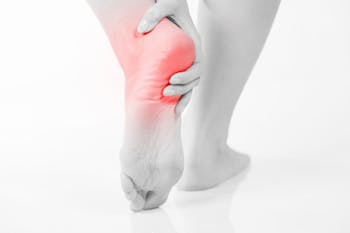
Parts of the Foot
The foot has 28 bones and is traditionally divided into three regions:
- The Hindfoot - begins at the ankle joint and stops at the transverse tarsal joint, also known ads the midtarsal, separates the rearfoot from the midfoot.
- The Midfoot - begins at the transverse tarsal joint and ends where the metatarsals begin - muscles and ligaments from the midfoot connect the forefoot to the hindfoot.
- The Forefoot - made up of the metatarsals (long bones between the middle of the foot and toe bones), phalanges (toe bones), and sesamoids (bones embedded within a tendon or a muscle that act like pulleys, providing a smooth surface over which tendons can slide to increase its ability to transmit muscular forces).
...and two columns:
- The Medial Column - a mobile column consisting of the talus, navicular, medial cuneiform, 1st metatarsal, and great toe bones.
- The Lateral Column - a stiffer column that includes the calcaneus, cuboid, and the 4th and 5th metatarsals.
Ankle Anatomy
The ankle joint is also known as the talocrural joint. It is formed by:
- Tibia - large and stronger of the two lower leg bones, which forms the inside part of the ankle
- Fibula - smaller bone of the lower leg, which forms the outside of the ankle
- Talus - a small bone between the tibia, fibula and calcaneus (heel bone)
- Lower (Subtalor) Ankle Joint - formed by the talus, calcaneus and navicular bone
The ends of each of the bones are covered by articular cartilage. The space in the joint is lined with a thin membrane called the synovium. The synovium cushions the joint and secretes a lubricating fluid (synovia), which reduces bone friction and help with fluid movement.
These bones are held together by a set of three strong bands of connective tissue, called ligaments:
- Anterior Tibiofibular Ligament - connects the tibia to the fibula
- Medial Collateral (Detoid) Ligament
- Lateral Collateral Ligament
A number of tendons attach the lower leg muscles to the foot and ankle bones.
The foot and ankle are complex structures that can easily be injured. Fortunately, many foot and ankle conditions can be treated conservatively with physical therapy. Physical therapists (PTs) are experts in the art and science of the evaluation and treatment of human movement dysfunctions. We care for people of all ages and treat a variety of muscle, joint and neurological conditions.
Conditions we have successfully treated:
- Ankle Pain
- Shin Splints
- Ankle Sprains
- Plantar Fasciitis
- Achilles Tendonitis
- Excessive Pronation
- Post Surgical Conditions
- Tibialis Posterior Tendonitis
What are my treatment options?
- Drugs
- Corticosteroid Injections
- Surgery
- Physical Therapy*
Advantages of Physical Therapy:
- No side effects.
- Cost-effective.
- Supported by clinical research*.
- Customized to treat the underlying cause.
Your Recovery Process:
- Pain Relief
- Recovery of Mobility or Stability
- Increased Strength
- Recovery of Walking and Functional Skills
- Independent Care
Components of Your Care:
- A thorough biomechanical evaluation.
- Extensive patient education.
- A customized treatment plan.
- Gentle hands-on techniques to relax the muscles.
- Effective joint mobilization techniques to decrease stiffness.
- Pain relieving modalities such as ice, heat, ultrasound or electrical stimulation.
- Targeted stretching for tight muscles.
- Walking retraining.
- Balance exercises.
- Shoe inserts (orthotic recommendations).
* Cited from the academic journal, JBJS (American). 2006;88; Am J Sports Med 1998 May; 26(3).
Treatments for Ankle and Foot Pain
Click the <PLAY> buttons in the square below to see videos of some treatments for ankle and foot pain.
Ankle Joint Mobilization
Hands-on therapeutic procedures intended to increase soft tissue or ankle joint mobility. Mobilization is usually prescribed to increase mobility, decrease joint stiffness, and to relieve pain. There are many types of mobilization techniques including Grimsby, Maitland, Kaltenborn, Isometric Mobilizations, etc.
Ankle Joint Passive Range of Motion
The movement of the ankle by the patient or therapist through a range of motion without the use of the muscles that "actively" move the joint(s).
Ankle Progressive Resistive Range of Motion
Exercises that gradually increase in resistance (weights) and in repetitions. PRE is usually prescribed for reeducation of muscles and strengthening. Weights, rubber bands, and body weight can be used as resistance.
Cryotherapy or Cold Therapy
Cold therapy is used to cause vasoconstriction (the blood vessels constrict or decrease their diameter) to reduce the amount of fluid that leaks out of the capillaries into the tissue spaces (swelling) in response to injury of tissue. Ice or cold is used most frequently in acute injuries, but also an effective pain reliever for even the most chronic pain. Cold therapy may be administered by using a cold pack or an ice massage as seen in the above video.
